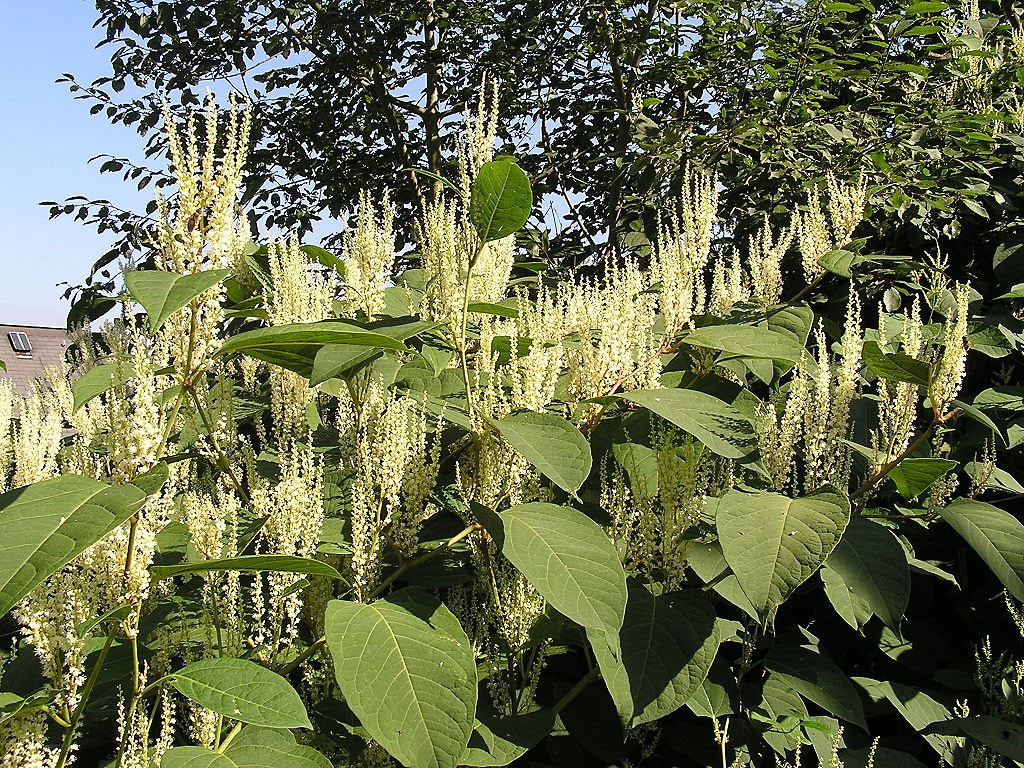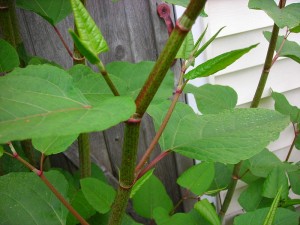Pity the have-knots – knotweed that is

Japanese knotweed is an aggressive invasive, but when young makes a passable rhubarb substitute and it may even yield a cancer treatment. Respect. Photo: MdE, Creative Commons, some rights reserved
Usually the have-nots wish for more, but the “have-knots” actually want less. Less knotweed, that is. Often called bamboo because of its hollow stems, prominent nodes and impressive growth rate, Japanese knotweed (Fallopia japonica) is well-established throughout New York State. As its name suggests, it’s from Japan (as well as Korea), and was brought to North America in the late 1800s as an ornamental.
In its home range it grows in some tough sites, including—reportedly—pure volcanic ash. Compared to that, just about anywhere in our region is a paradise. In back yards and vacant lots, along utility and rail rights-of-way, as well as stream and river banks, this exotic plant establishes quickly and forms dense thickets. Because knotweed can create instant privacy, some welcome it, but anyone who has tried to get this invader out of their garden or lawn consider it a scourge.
As invasive plants go, it could be worse. Knotweed doesn’t blister your skin like giant hogweed and wild parsnip do, or halt forest regeneration as is the case with swallow-wort. And, thankfully, it does not produce viable seed.

Why it’s also known locally as “bamboo” – the hollow segmented stem. Photo: Ancatdubh43, public domain
And it has some genuine good points. It is a source of resveratrol, a compound which is currently used to reduce inflammation and to treat some cancers. Its flowers produce loads of nectar, and are an important late-season nectary for honeybees and wild pollinators. Deer, rabbits and even livestock graze on it. It’s also a wild edible, featured in Euell Gibbons’ seminal book on the topic, “Stalking the Wild Asparagus.” The young shoots taste much like rhubarb, and can even be made into pie.
Of course knotweed has many strikes against it. It spreads fast and can be very hard to eradicate, especially in rough terrain. You can smother knotweed for a year only to have it reappear like Houdini when the cover is pulled off. Its tough perennial roots (rhizomes) can snake underground and pop up a new shoot 60-70 feet away from the parent colony. And it is easily moved accidentally, as a small bit of rhizome or section of stem is all it takes to start a new infestation.

Wall of knotweed out-competing native plants along a waterway. Photo: Roger Kidd, Creative Commons, some rights reserved
Along waterways, knotweed plant fragments get washed away during high-water events and create new colonies downstream. In some stretches of the Oswego and Salmon Rivers, the banks are walled by Japanese knotweed. It can restrict or eliminate water access, and it out-competes existing vegetation. Because its tops die back each fall it does not help prevent erosion the way native shoreline plants like willow and shrub dogwood do.
On high ground, though, I actually consider knotweed one of the easier invasive plants to manage. Non-chemical methods include aggressive hand-pulling followed by 2 to 3 years of smothering, or 5 to 7 years of weekly mowing. The latter may sound impossible, but I was able to eradicate an large patch of knotweed from my backyard this way.
As much as I try to avoid pesticides, I have to admit that glyphosate, the active ingredient in products such as Roundup, is very effective when applied in early fall, the optimal time, and at the right concentration. Stem injection, the labor-intensive process of injecting each stalk with a small dose of concentrated glyphosate, is safe to use right up to the water’s edge, and is even more effective than foliar sprays. Injection does require a licensed pesticide applicator.
For more information on knotweed, visit http://www.sleloinvasives.org or contact your local Cornell Cooperative Extension office.
Pesticide Disclaimer: Every effort has been made to provide correct, complete and up-to-date pesticide recommendations. Nevertheless, changes in pesticide regulations occur constantly, human errors are still possible. These recommendations are not a substitute for pesticide labeling. Please read the label before applying any pesticide and follow the directions exactly.
Paul Hetzler is a horticulture and natural resources educator with Cornell Cooperative Extension of St. Lawrence County.
Tags: gardening, invasive species, invasives, Japanese knotweed, japonica







